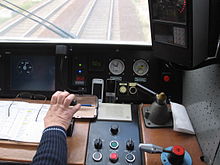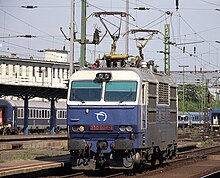ČSD series ES 499.0
| ČSD series ES 499.0 ŽSR / ZSSK series 350 Škoda type 55E |
|
|---|---|
|
Gorila
|
|
| Numbering: | ES 499.0001–0020 ČSD 350 001–020 ŽSR / ZSSK |
| Number: | 20th |
| Manufacturer: | Škoda , Plzeň |
| Year of construction (s): | 1974 prototypes 1976 series vehicles |
| Axis formula : | Bo'Bo ' |
| Gauge : | 1435 mm ( standard gauge ) |
| Length over buffers: | 16,740 mm |
| Length: | 15,500 mm |
| Height: | 4900 mm |
| Width: | 2940 mm |
| Trunnion Distance: | 8300 mm |
| Bogie axle base: | 3200 mm |
| Smallest bef. Radius: | 120 m |
| Service mass: | 89.6 t |
| Friction mass: | 89.6 t |
| Wheel set mass : | 22.4 t |
| Top speed: | 160 km / h |
| Hourly output : | 4200 kW |
| Continuous output : | 4000 kW |
| Starting tractive effort: | 210 kN |
| Hourly traction: | 134 kN |
| Continuous tensile force: | 126 kN |
| Driving wheel diameter: | 1250 mm |
| Power system : | 25 kV / 50 Hz ~ 3 kV = |
| Number of traction motors: | 4th |
| Drive: | Hollow shaft drive |
| Brake: | Hand brake air brake DK-GP (DK-GP + E mZ) electric resistance brakes |
| Train control : | Mirel VZ1 , partly ETCS |
| Train heating: | electric |
The ČSD class ES 499.0 (from 1988: class 350 ) is an electric two-system locomotive of the former Czechoslovak State Railways (ČSD). It can be used in the 3 kV direct current system in the north and east as well as in the 25 kV alternating current system in the west and south of the former Czechoslovakia , which means that there is no need to change locomotives at the system separation points.
history
The locomotives were created in the second half of the 1960s, because at that time the two electrical subnetworks - on the one hand 3 kV direct current, on the other hand 25 kV alternating current - were approaching each other and one had to think about the operation of the system separation points . At that time, it was expected that there would be around ten system separation points within the Czechoslovakian railway network. Operation with single-system machines and reclamping would not only have increased travel times, it would also have required the establishment of complex system switching stations. The increase in travel time particularly affected the heavy express trains between Prague and Bratislava. The system changing station was in Kutná Hora , where express trains normally did not stop, and there had to be changed over there before then. This was the basis for the demand for a new locomotive, which Škoda in Plzeň was commissioned to develop in 1969 . A strong and fast locomotive for speeds of up to 160 km / h was required for exquisite performance by the ČSD .
Prototypes
The first prototype, designated ES 499.0001 , was built in mid-1973. After the test at the manufacturer's works, test drives on the Velim railway test ring began with the first technical safety test , during which a speed of 180 km / h was reached even under both power systems. Then the locomotive was brought to Kutná Hora to test the transition from one power system to the other. From April 9, 1974, the machine and the measuring car drove the Slovenská strela express train from Bratislava to Prague and back.
On May 16, 1974, the locomotive passed the second technical safety test on the Velim railway test ring . It reached a speed of 219 km / h in record drives. Then it returned to regular operation in the Bratislava locomotive depot. The locomotive became part of the ČSD on December 28, 1974. It was housed in the Bratislava depot .
The second prototype ES 499.0002 was delivered at the end of 1974. After testing on the Velim railway test ring at speeds of 176 km / h, it was also handed over to the Bratislava locomotive depot in February 1975. Both prototypes were initially only used on the Bratislava - Prague route, and use was limited to the Slovenská strela express train , which both machines alternately hauled. Trips to Štúrovo were the exception. Due to the use of the dual system locomotives, the dispatchers had to be instructed urgently about the changed operating conditions. The dispatcher in Bratislava also had to constantly inform the dispatcher in Prague and vice versa about the tension of the train so that it could organize a locomotive to be re-tensioned in the event of a single-system locomotive in Kutná Hora . The locomotives were not allowed to travel to Hungary .
Both prototypes initially had a restriction on their use in truck journeys . In this case, the locomotives were subject to a speed limit due to insufficient braking percentages . Therefore, transfer trips were initially carried out with a train or a locomotive of another series. These restrictions only ended after the prototypes had been adapted to the series machines.
Series locomotives
Series production of the ES 499.0 series locomotives took place at Škoda in 1975. After the technical safety tests on the Bratislava - Sládkovičovo line in the AC network and Kolin - Úvaly or Kolin - Český Brod in the DC voltage network, the 18 series locomotives were also located in the Bratislava locomotive depot. From December 4, 1975, the locomotives could also run to Budapest . The last locomotive to be delivered, the ES 499.0020 , differed from the original locomotives from the start in that it had a new, so-called unified engine driver's cab , which is now standard for all locomotives of this series and other new locomotives.
technical description
In their time, the locomotives were the most powerful four-axle multi-system locomotives in the world and the fastest locomotives on the Czechoslovak State Railways. In terms of performance, it could only be surpassed by the French CC 21000 , but this locomotive had six axles.
The locomotive is a box locomotive with two driver's cabs at the top. There are four rectangular windows on one side wall and blinds on the other side to ventilate the traction motors. The base frame and box form a self-supporting welded construction. The locomotive is supported in four points on two two-axle bogies. Their design had been tested on the E 469.3030 locomotive . The drive is provided on one side with Škoda - hollow shaft drive . The DC traction motors are connected to the bogie frame via a torque arm. The bogies are spring-loaded in two stages with steel coil springs and equipped with hydraulic vibration dampers. The wheels are spoked wheels with twelve star-shaped spokes. The axles originally existed as solid material, after the modernization the machines were given hollow axle shafts. One wheel of each bogie could be sanded in the direction of travel.
From an electrical point of view, the locomotive is a classic DC machine with an additional transformer and silicon diodes as well as smoothing reactors for operation in the AC network. The contact wire voltage is picked up with two identical single-arm pantographs , which develop a variable contact pressure depending on the power system. The transformer, which is mounted under the frame between the bogies, has the type designation ELH 7060-53 and is oil-cooled. The power regulation was originally carried out with resistance control. Although the Škoda locomotives were therefore described by some experts as rather ancient , it must be said that the manufacturer also had to fulfill export obligations and could therefore only rely on well-engineered, reliable designs.
From 1997 the locomotives were modernized. Since then, the entire control of the electric locomotive has been carried out automatically via a speed controller and a tension and braking force controller. Since then, this has been done by the MIREL driving and diagnostic system . The continuous output of 4000 kW enables it to transport 650-t express trains on the flat at 160 km / h and with a gradient of 10 ‰ at 105 km / h.
The locomotives are also elegant on the outside. This is particularly effective due to the compact shape, the sloping front in the area of the driver's cab window, the shape of the headlights and the single-arm pantograph. The paintwork also had an effect, as it differed from the single-system locomotives in that it was mostly blue and white. Some vehicles were also painted red, white and red. The locomotives were given the nickname Gorila by the operating service. After the modernization, which in addition to changing the electrical equipment also included equipping them with new safety front windows, some locomotives were adapted to the current ZSSK color scheme , with the lower part of the locomotive body up to the headlights in white, the upper part in red and the Roof was executed in gray.
commitment

Their field of application was and is the transport of express, express, IC and EC trains on routes with system separation points . In their heyday at the end of the 1970s, they were responsible for transporting heavy express trains such as the Balt-Orient-Express and the Pannonia-Express , some of them in cross-country routes between Budapest and Děčín hl. n. with up to 13 express train passenger cars. It was particularly impressive to experience the ES 499.0 in the Bratislava - Brno section with a top speed of 160 km / h.
The successful use in practice led to the development of the universal locomotive series ES 499.1 (today: series 363) and the series 372, which can also be used in Germany . The E 499.2 series (since 1988: 150 series) was derived from the locomotives for pure DC operation.
The locomotives all went to the Slovakian ŽSR and then to the ZSSK , where 18 locomotives are still in use today. The ES 499.0010 and ES 499.0009 are retired after accidents. The ES 499.0010 derailed in 1977 while traveling in front of the "Meridian" in the Bratislava hlavná stanica station and was so badly damaged that it had to be retired two years later. The same fate experienced the ES 499.0009 on November 10, 1989, which ran in front of the Balt-Orient-Express in the Nové Kopisty station on a passenger train consisting of a class 460 unit . Three wagons of the passenger train and the ES 499.0009 were destroyed.
Up until 2014, the locomotives were the regular haul of EuroCity trains on the Praha - Břeclav - Bratislava - Budapest line, even on routes that do not touch Slovakia (Prague - Břeclav with a locomotive change to Vienna). Since the timetable change in 2014, the locomotives on these routes have been gradually replaced by the new 380 series .
In order to use the top speed of 160 km / h with the IC trains Bratislava – Žilina - Košice , around half of the locomotives were equipped with ETCS on-board units.
See also
- List of locomotive and multiple unit series of the ČSD
- List of locomotive and multiple unit series of the ŽSR
literature
- the model railroader - vehicle archive (8/1975, page 249)
Web links
- Website for the ES 499.0 series (Czech)
- 350 series website (Czech)
- Photo of the 350.013 in the new ZSSK design on k-report.net
Individual evidence
- ↑ a b www.prototypy.cz, 350.001
- ↑ Internet page about the locomotive ЧС200, page 2
- ↑ www.prototypy.cz, Series locomotives
- ↑ EK 05/2014, page 117
- ↑ Description of the locomotive on www.atlaslokomotiv.cz
- ↑ Eisenbahn-Kurier 12/2014, Foreign missions, Hungary, page 32



